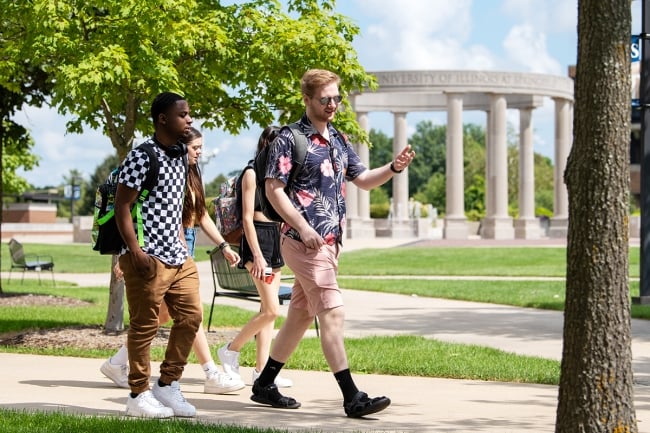You have /5 articles left.
Sign up for a free account or log in.

Students at the University of Illinois Springfield, which will begin offering in-state tuition to neighboring Iowa and Missouri counties in 2024.
Blake Wood/University of Illinois
A high school student in Davenport, Iowa, or St. Louis, Missouri, will soon be able to attend the University of Illinois Springfield for the same price as an Illinois resident, thanks to a tuition-matching program approved last month by the UI system board of trustees.
Designed to attract a larger pool of applicants and shore up falling in-state enrollment, the program, set to begin fall 2024, is just the latest example of a trend that’s picking up speed in the regions hit hardest by demographic shifts, most notably the Midwest and Northeast.
Tom Harnisch, vice president for government relations at the State Higher Education Executive Officers Association, said adopting tuition policies meant to entice students from neighboring states is particularly pronounced among regional four-year universities that have long relied on local populations.
“The institutions that are really on the front lines of this are regional public universities,” he said. “They were designed to provide higher education to specific areas of the state, and so now that those areas are declining in population, they’re looking beyond their regions.”
Vickie Cook, Springfield’s vice chancellor for enrollment and retention management, said the initiative is a pilot program meant to help regionally local students who are interested in attending but can’t afford to pay out-of-state tuition. She anticipates that anywhere from 75 to 100 students from the three counties in the pilot will take advantage of the program in its first year, up from the 30 who currently attend.
It’s also an experimental solution to Illinois’ dual crisis of declining college enrollment and workforce migration. Illinois has experienced a record population drop in recent years, losing over 100,000 residents in 2022 alone. In expanding access across state borders, Cook said the system board is trying to uplift out-of-state numbers to make up for a dive in the state’s population, especially its rural areas. And if the program is successful, Cook said it could be expanded further into those states and at other campuses in the system.
“This is one piece in a larger portfolio of approaches to the demographic cliff and other enrollment issues,” Cook said. “Illinois has had a lot of outmigration, so we’ve been looking for solutions to that … the hope is these students come over and stay after graduating.”
But the neighbors Illinois is looking to pull from aren’t exactly flush with students either. Postsecondary enrollment in Iowa fell by 13 percent from 2019 to 2023, the fifth largest drop in the country, according to data from the National Student Clearinghouse. And enrollment at the University of Missouri-St. Louis, a regional public college located within the range of Springfield’s pilot program, has fallen by over 35 percent since 2011.
Edward Conroy, a senior adviser at New America’s education policy team, said increasingly fierce competition among states was probably an inevitable result of current enrollment trends—but that it’s hardly sustainable.
“If you need to maintain a certain enrollment goal to be solvent as an institution, and you’ve got fewer of your own students in a Midwestern state with a declining high school age population, then unless you’re willing and able to shrink, you’re going to go to your neighboring state,” he said. “But if you’re peeling off from your neighbors, you’re going to be vulnerable to them doing the same to you.”
From Cooperation to Competition
Conroy said the more cutthroat approach marks a departure from a bygone era of cooperation.
Some older tuition-matching agreements function more like partnerships, such as the Western Undergraduate Exchange, a reciprocal tuition-reduction partnership founded in 1987 among the 16 member states of the then-nascent Western Interstate Commission for Higher Education (WICHE).
Illinois’ program is not reciprocal. Neither are the flagship tuition-matching programs at the State University of New York system or the University of Maine, both of which were launched in the past ten years to draw students from far-flung states, not just nearby counties.
“One important facet of this is whether these approaches are being used to enhance cooperation and support for students, or to try and poach students from neighboring states,” he said. “When WICHE was formed, the future of enrollment looked very bright … A big piece of this change is that the enrollment landscape looks very different today. It’s much more competitive.”
In some cases, that competition has manifested in heightened cross-state tensions. SUNY has been particularly dogged in its plays for out-of-state students. Last year, it launched a program guaranteeing that 22 of its campuses would match the in-state tuition of flagship universities in eight select states—some nearby, like Connecticut and New Jersey, and others distant, like California and Illinois.
“My suspicion is that it was very targeted at states they already know are sending a number of students,” Conroy said. “Somebody did some very good analysis and said, ‘Here are the states where we get a lot of students, and we could probably get some more if we get creative.’”
The plan, combined with SUNY’s free tuition program for students whose individual or family income is below $125,000 from any state, has sapped students from areas already hurting from enrollment declines. The gambit appears to have paid off for SUNY, which saw a massive increase in applications last year.
But SUNY’s efforts have also exacerbated enrollment challenges elsewhere. Pennsylvania State System of Higher Education commissioner Daniel Greenstein, who oversees a constellation of largely regional public institutions and has been managing a planned consolidation to cope with falling enrollment, called the SUNY policies “aggressive” in an interview last month.
A SUNY spokesperson did not respond to a request for comment.
Even measures to bolster in-state retention are threatening to upset a delicate balance in some demographically challenged regions.
Last year, Minnesota launched North Star Promise, a free tuition program for resident students. It was meant to keep Minnesotans in the state’s public colleges, which have struggled with a 29 percent enrollment dive since 2013—not to reel in students from neighboring states. But North Dakota, the fourth least populous state, has fewer college-age residents than most and relies on students from Minnesota’s rural northwestern counties to fill seats at its public colleges. North Dakota University System chancellor Mark Hagerott said there are about 10,000 Minnesotans spread across the system.
Most of those students are concentrated a short way across the Minnesota border at North Dakota State University in Fargo, where in fall 2019 they made up about half the total undergraduate population and outnumbered in-state students, according to an institutional enrollment report. At the University of North Dakota Grand Forks, also just over the border, Minnesota residents make up 27 percent of the student body.
So when North Dakota lawmakers and higher ed leaders heard of Minnesota’s tuition plan, they feared it could be “catastrophic,” in the words of NDSU president David Cook.
Hagerott said he hopes students look at “the full picture” of what North Dakota schools offer, but admits that the North Star Promise program is more likely than not to tear away at least some of the system’s Minnesota students.
“The word ‘free’ is a powerful advertising tool,” he said. “Families who are just kind of overwhelmed by the complexity of FAFSA forms and North Dakota scholarships, I could certainly see them just seeing the headline.”
Building Pressure for Affordability
Despite the exodus of Pennsylvania students spurred by SUNY’s robust out-of-state funding programs, Greenstein acknowledged that, at the end of the day, students are making a financial decision, comparing prices that Pennsylvania’s public institutions—some of the least-well funded in the country—just can’t match.
Harnisch, of SHEEO, hopes the added pressure will force states to rein in college cost in order to compete.
“There could be real benefits for students here, to have more opportunities to attend institutions that, if they had to pay the full out-of-state tuition price, they might not be able to attend,” he said. “That’s a good thing.”
There is some movement in that direction. Minnesota’s free tuition program has inspired North Dakota state senator Tim Mathern to put forth a proposal for a copycat program, titled “North Dakota Promise”—a not-so-subtle pun on Minnesota’s North Star Promise program.
Hagerott isn’t confident that Mathern’s proposal will gain traction. “We’re a very self-sufficient state,” he said, “and giving something away for free kind of goes against the North Dakota spirit.” But he does believe that as the enrollment wars heat up in the nation’s struggling regions, colleges and lawmakers will resort to more dramatic measures, both to keep their students from the grasping hands of others and to lure more over their borders.
“This is a sign of the times, unfortunately,” he said. “It’s just going to be part of what happens increasingly across the country.”
Conroy, like Harnisch, hopes that tuition reduction programs beget more of the same — a “race to the top, rather than a race to the bottom,” he said. But he fears that fiercer competition will necessarily lead to losers as well as winners in the enrollment tug-of-war. He said federal stewardship could help prevent that.
“It points to why there is such a need for a strong federal-state partnership around free public higher education,” he said. “Absent that, we're going to continue to see states making, frankly, rational choices to attract out of state students and maintain the solvency of their public higher education systems.”
Regardless, Conroy said focusing on poaching traditional-age students from beyond usual recruitment zones is a “short-term solution.” He hopes that regional public universities turn toward adult learners or those with partially-completed degrees, a population of about 40 million that is growing year over year, according to data from the National Student Clearinghouse.
Or, he said, they can keep fighting over each other’s traditional applicants. They should just be aware that eventually, there will be no more ponds to fish in.









